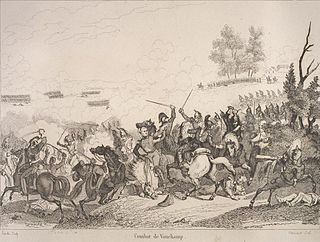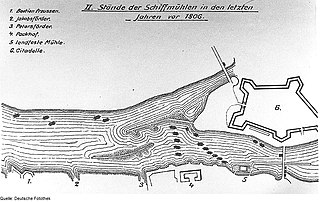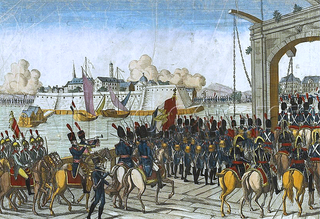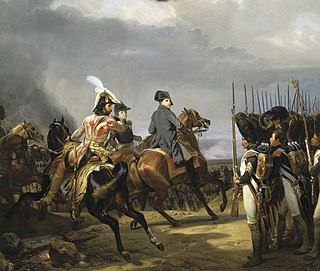
The Battle of Vauchamps was the final major engagement of the Six Days Campaign of the War of the Sixth Coalition. It resulted in a part of the Grande Armée under Napoleon I defeating a superior Prussian and Russian force of the Army of Silesia under Field-marshal Gebhard Leberecht von Blücher.

The Battle of Ostrovno was a military engagement that took place on 25 July 1812, between French forces under the command of King of Naples Joachim Murat and Russian forces under General Ostermann-Tolstoy and ended with the Russian forces retreating from the battlefield.

The Battle of Wavre was the final major military action of the Hundred Days campaign and the Napoleonic Wars. It was fought on 18–19 June 1815 between the Prussian rearguard, consisting of the Prussian III Corps under the command of General Johann von Thielmann and three corps of the French army under the command of Marshal Grouchy. A blocking action, this battle kept 33,000 French soldiers from reaching the Battle of Waterloo and so helped in the defeat of Napoleon at Waterloo.

This is the complete order of battle for the four major battles of the Waterloo Campaign.

The Battle of Lübeck took place on 6 November 1806 in Lübeck, Germany between soldiers of the Kingdom of Prussia led by Gebhard Leberecht von Blücher, who were retreating from defeat at the Battle of Jena–Auerstedt, and troops of the First French Empire under Marshals Murat, Bernadotte, and Soult, who were pursuing them. In this War of the Fourth Coalition action, the French inflicted a severe defeat on the Prussians, driving them from the neutral city. Lübeck is an old Baltic Sea port approximately 50 kilometres (31 mi) northeast of Hamburg.

The Grenadiers à Cheval de la Garde Impériale constituted a heavy cavalry regiment in the Consular, then Imperial Guard during the French Consulate and First French Empire respectively. They were the senior "Old Guard" cavalry regiment of the Imperial Guard and from 1806 were brigaded together with the Dragons de la Garde Impériale.

Caldiero 1805 Order of Battle

The siege of Magdeburg was a siege of the city that took place from 25 October to 8 November 1806 during the war of the Fourth Coalition. A French force, initially under the command of Marshal Grand Duke of Berg Joachim Murat, then a French army Corps under the command of Marshal Michel Ney laid siege and eventually obtained the surrender of Franz Kasimir von Kleist's Prussian force that had taken refuge in Magdeburg, Prussia's second city.

In the Capitulation of Stettin on 29–30 October 1806, Lieutenant General Friedrich Gisbert Wilhelm von Romberg surrendered the garrison and fortress to a much smaller French light cavalry brigade led by General of Brigade Antoine Lasalle. This event was one of a number of surrenders by demoralized Prussian soldiers to equal or inferior French forces after their disastrous defeat at the Battle of Jena-Auerstedt on 14 October. Stettin, now Szczecin, Poland, is a port city on the Oder River near the Baltic Sea, about 120 kilometres (75 mi) northeast of Berlin.

In the Siege of Hamelin or Siege of Hameln, First French Empire forces captured the fortress of Hamelin from its garrison composed of troops from the Kingdom of Prussia. The siege was begun by the VIII Corps under French Marshal Édouard Adolphe Casimir Joseph Mortier. The marshal initially left General of Division Jean-Baptiste Dumonceau in charge of operations. General of Division Anne Jean Marie René Savary soon arrived to conduct negotiations with the Prussian commander General Karl Ludwig von Lecoq, who was quickly persuaded to surrender. Technically, the operation from the War of the Fourth Coalition was a blockade because a formal siege never took place. Hamelin is located 36 kilometers southwest of Hanover.
The Combat of Korneuburg was a relatively minor rearguard action fought by Austrian VI Korps of the Kaiserlich-königliche Hauptarmee under Johann von Klenau against elements of the French IV Corps of the Grande Armée d'Allemagne, under the command of Claude Legrand. The brief combat ended in favour of the French.
The Combat of Stockerau was a minor rearguard cavalry skirmish fought by elements of the cavalry of Austrian VI Korps of the Kaiserlich-königliche Hauptarmee under Ludwig von Wallmoden-Gimborn against a single Hessian Guard Chevauleger regiment, under the command of French General Jacob François Marulaz. The combat ended in favour of the Austrians.
The Combat of Schöngrabern was a relatively minor rearguard action fought by Austrian V Korps and supporting elements of the Kaiserlich-königliche Hauptarmee under Prince Heinrich XV of Reuss-Plauen against elements of the French IV Corps of the Grande Armée d'Allemagne, under the command of Claude Legrand.

The Jena-Auerstedt Campaign Order of Battle is listed below. The order of battle includes units from the First French Empire and the Kingdom of Prussia that fought each other in the campaign that included the decisive Battle of Jena-Auerstedt on 14 October 1806. The order of battle may be useful to trace the battles of Schleiz and Saalfeld, which occurred before Jena-Auerstedt, as well as battles and capitulations that happened after 14 October, such as Erfurt, Halle, Prenzlau, Pasewalk, Stettin, Waren-Nossentin, and Lübeck.

Baron Samuel-François Lhéritier de Chézelles was a French soldier who rose through the ranks during the French Revolutionary Wars and Napoleonic Wars, eventually gaining promotion to the military rank of Général de Division.

Georg Dubislav Ludwig von Pirch was a Prussian lieutenant general who fought in the Napoleonic Wars, participating in the battles of Leipzig and Waterloo. He is sometimes referred as Pirch I to distinguish him from his younger brother, Otto Karl Lorenz von Pirch, referred as Pirch II.

The Waterloo Campaign commenced with a pre-emptive attack by the French Army of the North under the command of Napoleon Bonaparte. The first elements of the Army of the North moved from their peacetime depots on 8 June to their rendezvous point just on the French side of the Franco-Belgian border. They launched a pre-emptive attack on the two Coalition armies that were cantoned in Belgium—the Anglo-allied army under the command of the Duke of Wellington, and a Prussian army under the command of Prince Blücher.

After their defeat at the Battle of Ligny the Prussians successfully disengaged and withdrew to north to Wavre where they reorganised and then three corps advanced westward to attack the right flank of the French army at the Battle of Waterloo. The French were desultory in the aftermath of Ligny. Napoleon wasted the morning of 17 June by taking a late breakfast and going to see the previous day's battlefield before organising a pursuit of the two Coalition armies. He took the reserves and marched with Marshal Ney in pursuit of the Duke of Wellington's Anglo-allied army, and he gave instructions to Marshal Grouchy to pursue the Prussians wherever they were going and harry them so that they had no time to reorganise.




















